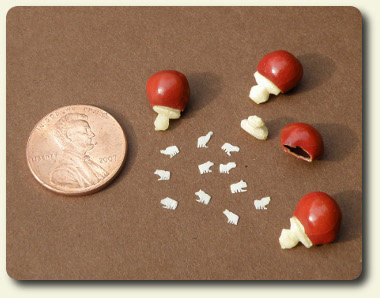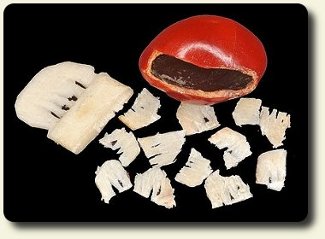
September 2010, Issue 8
Manjai Beans
Page 52

 Jack might have grown a magic beanstalk but he didn't have magic charm beans filled with one dozen amazing teeny carved magical animals or a dozen elephants.
Jack might have grown a magic beanstalk but he didn't have magic charm beans filled with one dozen amazing teeny carved magical animals or a dozen elephants.
The beans themselves come from the "manjadi," (Adenanthera pavonia) or good luck tree, of India. The little red pod (manjadikuru) looks like a lentil. A lentil that has been hollowed out and a tiny stopper inserted to hold the carvings inside.
The first bean carvings design, the Hindu Lucky Bean, holds a dozen less-than-1/8th inch tall tiny carvings from scraps of ivory in the shapes of a dozen different special native Indian animals. These bean animals are supposed to gift the owner of the bean with their strengths.
 The second bean design, filled with a dozen elephants, is the subject of legend.
The second bean design, filled with a dozen elephants, is the subject of legend.
In Southwestern India lies the sacred temple of Guruvayoor. Just inside the entrance to this temple, sits a large uruli, (a heavy pot) filled with the bright red "manjadikuru" seeds - the symbol of a lone peasant woman's devotion.
These seeds are not filled with carven animals or elephants but they are just as special; the glossy bright red seeds themselves are sacred. It is believed that the devotee who plunges his hands into the seeds three times is cured of all diseases and granted prosperity.
The elephant connection comes in the form of the Ekadasi festival of the Mandala season (November-December) when a procession of decorated elephants is taken out to honor 'Guruvayoor Kesawan.' Guruvayoor Kesawan was a gift to the temple by the king of Nilambur, a monthly offering to Krishna.
Custom Dolls, Houses & Miniatures / CDHM







